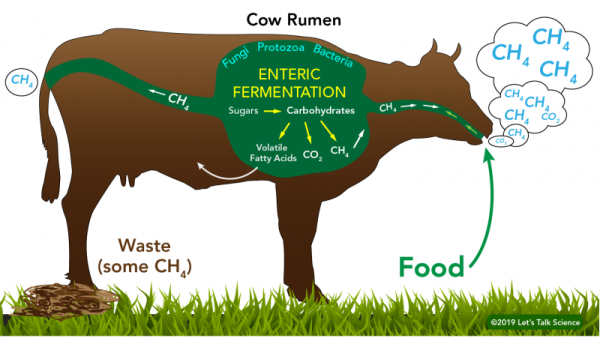Guess what? Cows have picked up on our fad dieting habits. They think that by eating more seaweed, they will be able to reduce their disgusting burping habits, which is what all the cow influencers are doing. Perhaps this is a bit dramatized, but it isn’t so far from some exciting events happening today.
It has long been known that animal farming is a major source of our climate troubles. With livestock using up a third of global freshwater resources and occupying 30 percent of arable land, animal cultivation is one of the most resource-intensive human industries. However, livestock is not only a resource drain; it can release greenhouse gases that accelerate climate change. In fact, an individual cow will release around 220 pounds of methane per year through its digestive system. An equal quantity of methane is up to 28 times more capable of trapping heat than carbon dioxide, and so, because cows mostly burp up methane, animal agriculture creates a very impactful 14.5 percent of total greenhouse gas emissions. With almost 9,000 cattle ranches averaging 3,942 acres and in being the state with the 23rd highest population of cows in the country, New Mexico is at the forefront of this issue.
Excitingly, there have been some significant steps towards making the use of these optimal livestock diets a reality, such as the widely-publicized experimentation with algae, seaweed, and another additive called 3-nitrooxypropanol (3-NOP). These additives work on the enteric systems of ruminates (seaweed works via the use of bromoform or CHBr3) where they alter the process of digestion so that less methane is outputted.

These would be added as an extra ingredient that composes a small percentage of animal feed. This means that they would work to reduce methane emissions without really altering the ways cattle is raised.
Much research has proven these substances to be working. According to one study, red seaweed or Asparagopsis taxiformis fed to cows can reduce their enteric methane output by upwards of 80 percent! This study used a GreenFeed machine to measure gas emissions (including carbon dioxide).

According to their consumption of organic matter, three groups of cows were fed varying concentrations of red seaweed. Carbon dioxide output did not change much between groups. Feeding the cows the seaweed even lowered how much dry matter they ate while not changing how much their mass increased per day, meaning that the price of maintaining cows could also be lowered with this method! This study also tested the meat quality of the cows that were experimented on and concluded that there were no noticeable effects on it.
Another similar study testing an algae substance called Alga 1.0 concluded that “feeding Alga 1.0 reduced DMI [dry matter intake] up to 13.3%, did not impact digestibility, and significantly reduced CH4 emissions up to 63%.”A National Institute of Health briefing states that “[p]roviding 3-nitrooxypropanol to dairy and beef cattle in research studies has consistently decreased enteric CH4 production by 30% on average, with reductions as high as 82% in some cases.”
So, essentially, there is solid information that all three additives are functional.
These results are extremely exciting, and these new practices have been actually put into use by farms: for example, limu kohu, a type of Hawaiian seaweed that is used by native Hawaiians, has been fed to goats on Ahualoa Farm on the Big Island. Using a laser to measure methane emissions, this farm’s method worked to reduce them by 70 percent.

The discovery of additives to reduce greenhouse gas emissions in farm animals seems like it is a solution to all of our animal agriculture climate issues. And, certainly, these steps forward have great promise for large-scale use. However, there is still a long way to go to reduce the destructiveness of our consumption. For example, the cattle industry is responsible for 80% of Amazonian habitat loss. Can this issue really be solved without boycotting bovine products altogether? Maybe not, but for those who are not willing to change their diet, these additives do represent at least an improvement in the magnitude of how much we affect the environment.
Seaweed can be harvested, then freeze-dried, transported, and used by virtually any animal-raiser. The actual ecological impacts of seaweed farming itself are not negative, as it “requires almost no land, water, or greenhouse gases to grow, [and it] can also pull carbon[dioxide] out of the atmosphere,” according to the Nature Conservancy. The same preservation process could be done with algae, and 3-NOP can also be easily moved. This means that even in a (*cough, cough*–very beach-less) state like New Mexico, these additives could be useful.
Personally, I’m excited to see what we’ll discover next that will help us live more sustainably. Although 3-NOP, red seaweed, and algae are not widely-utilized in the animal industry (yet), the research of these new additives certainly shows that we’re capable of innovative—and sometimes very surprising—change for the better.


















